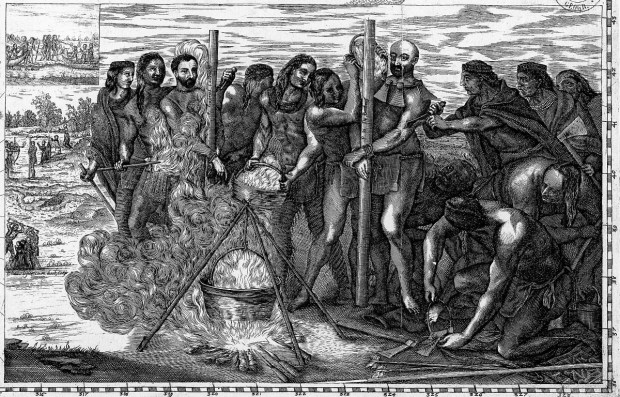Lenten Campaign 2025
This content is free of charge, as are all our articles.
Support us with a donation that is tax-deductible and enable us to continue to reach millions of readers.
Through the Jesuit Relations, chronicleswritten by the missionaries themselves, we learn of the eight Jesuit martyrs — their mission, success, failure, and, most importantly, the brutality they faced between 1632 and 1672.
Gabriel Lalemant was an academic, a brilliant scholar born in Paris, and the youngest of six children. Despite his frail health, he wanted to sail across the Atlantic and preach among the First Nations in New France. When he pronounced his three vows to complete his novitiate, he added a fourth—a vow to consecrate himself to foreign missions.
His departure took place later than he hoped. His superiors hesitated. Would his health withstand the voyage and hardships in store?
Missionary hopes delayed
The young Jesuit had to wait several years. He was employed in France serving God in various institutions—a Jesuit professor of philosophy and chaplain of a Jesuit college, among others. Finally, the news he had anxiously awaited came in 1946.
Father Gabriel Lalemant left France that summer to travel to Canada, a long three-month journey in those days. On arrival, the young Jesuit wanted to live among the First Nations tribes immediately, but his superiors held him back. Yet again, he had to wait, this time in Quebec.
His superior and uncle, Jerome Lalemant, wanted to curb his nephew's zeal, so he found work among the Quebec colonists. Father Gabriel Lalemant said Mass and preached while learning the Huron language.

Assistant to a future saint
Gabriel Lalemant’s fervent prayers were finally answered two years after his arrival. On July 24, 1648, he was allowed to leave Quebec to be Father Jean de Brébeuf’s assistant. The fellow Jesuit, himself an accomplished scholar, lived closely with the Huron tribe in charge of the mission at St. Ignace, a site that he had set up.
Paddling up the St. Lawrence River was fraught with dangers from the rapids and obstructions. It was not easy, especially for someone like Fr. Lalemant, who was in poor health.
Father de Brébeuf described the difficulties of portaging the canoes during his earlier trip:
One must land and carry on his shoulder, through the forest or over high rocks, all the baggage and the canoes. This is accomplished with great labor, for there are portages one, two, and three leagues long, and for each, several trips back and forth must be made, no matter how few our bundles may be.
A dangerous and difficult work
The Iroquois tribe, meanwhile, was becoming more and more aggressive in their attacks against native villages and Christians. Father de Brébeuf had recently built a new residence at St. Ignace, fortifying it to make it impregnable.
The two priests worked side by side, traveling from village to village, giving their services to the natives. Everyone was on their guard during these weekly visits, aware of possible attacks from the rebels.
Fr. Gabriel Lalemant wrote:
My Jesus and my Love, Thy Blood, shed for barbarians as well as for us, must be efficaciously applied for their salvation. Aided by Thy grace, I offer myself to co-operate in this work and to sacrifice myself for them.
Iroquois attack
In March 1649, about a thousand Iroquois arrived on the Huronia border at dawn. They battered down the palisades at St. Ignace, and once the fortifications were down, they moved inland, attacking and killing
Meanwhile the two Jesuits, intent on redeeming the followers, stood in their midst, baptizing and giving absolution. The resident Hurons struggled to defend the residence, but in vain: they were no match for the attackers and a massacre ensued.
Some fleeing Hurons advised the missionaries to escape with them, but the two Jesuits decided to stay with the prisoners.

Torture and death
The agony of the two priests started straightaway.
The rebels cut off their fingernails and applied a hot red hatchet to their armpits. They then tied the priest to posts, continuing the torment with hot flames applied to their bodies.
Father de Brébeuf perished from his torture by the end of the day, with Father Lalemant helplessly witnessing by his side.
Gabriel Lalemant’s torment continued until the following day. According to reports, the rebels split his jaw, opened his mouth wide open, and drove burning brands down his throat. His suffering was long and intense. The brave but frail saint somehow withstood the torture for over 12 hours, only dying when they tore his heart out.
Sr. Mary of the Incarnation, a French Ursuline nun who served in Quebec, later wrote of Lalemant:
God, by the miracle of his grace, wanted to show in his person what an instrument can do, however puny it may be when he chooses it for his glory and his service. It was fifteen full hours of horrible torment."
Gabriel Lalemant was beatified by Pope Pius XI on June 21, 1925, and canonized by the same Pope on June 29, 1930.










